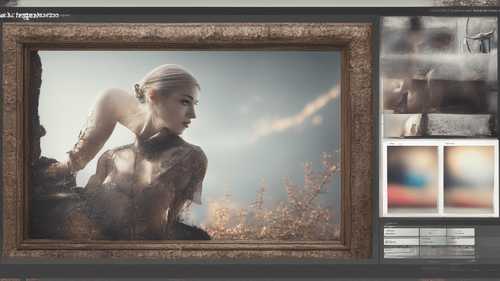
Introduction
In an increasingly visual digital landscape, the ability to decipher and communicate the content of images is paramount. Enter Image to Text Description AI, a groundbreaking technology that bridges the gap between visual content and textual comprehension. This article explores the dynamic realm of Image to Text Description AI, delving into its applications, significance, and transformative potential.
Image to Text Description AI: Enhancing Accessibility and User Experience
As the digital world becomes more inclusive, ensuring equal access to information for all individuals becomes a crucial objective. Image to Text Description AI plays a pivotal role in achieving this goal. By converting visual elements into descriptive text, this technology empowers visually impaired individuals to engage with images that were once inaccessible to them.
How Image to Text Description AI Works
Image to Text Description AI employs advanced machine learning algorithms to analyze images and generate accurate textual descriptions. This process involves object recognition, scene analysis, and context comprehension. The AI system identifies objects, assesses their spatial relationships, and crafts concise and coherent descriptions.
Applications in Digital Communication
The applications of Image to Text Description AI extend far beyond enhancing accessibility. In the realm of digital communication, this technology enables brands to convey their visual content to a wider audience. Social media platforms, websites, and marketing campaigns can now effectively engage users who rely on text-based communication.
Impact on User Experience
Image to Text Description AI contributes significantly to user experience by providing comprehensive and contextually relevant information. Users can interact with images more meaningfully, making their online interactions more engaging and satisfying. This technology also fosters a sense of inclusivity and diversity in the digital sphere.
The Benefits of Image to Text Description AI
Content Accessibility and Inclusivity
Image to Text Description AI addresses a longstanding challenge in content accessibility. By transforming images into text, it ensures that visually impaired individuals have equal access to visual content. This inclusivity aligns with principles of diversity and equal representation.
SEO Optimization and Discoverability
Search engine optimization (SEO) relies heavily on textual content. Image to Text Description AI contributes to SEO efforts by generating descriptive text that can be indexed by search engines. This improves the discoverability of visual content and enhances a website's overall visibility.
Empowering E-Commerce and Online Shopping
In the realm of e-commerce, product images are crucial for driving sales. Image to Text Description AI enables potential buyers to receive detailed information about products, thereby facilitating informed purchasing decisions. This technology revolutionizes online shopping experiences.
Education and Learning Enhancement
Educational platforms can leverage Image to Text Description AI to provide comprehensive explanations of complex visual concepts. This benefits both traditional and online learning environments, catering to diverse learning styles and preferences.
Innovative Applications Across Industries
Healthcare and Medical Imaging
In the healthcare sector, Image to Text Description AI contributes to diagnostic accuracy and communication between medical professionals and patients. Complex medical images can be translated into easily understandable descriptions, improving patient engagement and treatment understanding.
Tourism and Travel
For the travel industry, Image to Text Description AI enhances the virtual exploration of destinations. Travel enthusiasts can now receive detailed descriptions of landmarks, natural wonders, and cultural sites, enriching their virtual travel experiences.
Art and Cultural Heritage
Art galleries and museums can utilize Image to Text Description AI to provide insightful narratives for their exhibits. Visitors can engage with artworks on a deeper level, gaining historical, cultural, and artistic context.
Urban Planning and Architecture
Image to Text Description AI finds applications in urban planning and architecture, enabling stakeholders to communicate design concepts and urban developments effectively. Visual renderings can be transformed into detailed textual explanations for community engagement.
Overcoming Challenges and Ensuring Accuracy
While Image to Text Description AI offers tremendous benefits, ensuring accuracy remains a challenge. The technology must accurately identify objects, scenes, and emotions depicted in images. Continuous refinement and robust training datasets are essential for achieving high precision.
FAQs
How does Image to Text Description AI benefit individuals with visual impairments?
Image to Text Description AI converts visual elements into descriptive text, allowing visually impaired individuals to comprehend images that were previously inaccessible to them.
Can Image to Text Description AI be used for enhancing social media engagement?
Absolutely, Image to Text Description AI enables brands to engage a wider audience on social media platforms by conveying visual content through descriptive text.
What role does Image to Text Description AI play in e-commerce?
In e-commerce, Image to Text Description AI provides detailed information about products, empowering online shoppers to make informed purchasing decisions.
Is Image to Text Description AI applicable only to digital platforms?
No, Image to Text Description AI has diverse applications, including healthcare, education, tourism, and urban planning, among others.
How accurate is Image to Text Description AI in generating textual descriptions?
The accuracy of Image to Text Description AI depends on robust training datasets and ongoing refinement efforts. Achieving high precision is crucial to ensure accurate descriptions.
What challenges does Image to Text Description AI face?
One of the main challenges is ensuring accurate identification of objects, scenes, and emotions in images. Continuous improvement and training are essential to overcome these challenges.
Conclusion
Image to Text Description AI stands as a testament to human innovation and the relentless pursuit of a more inclusive digital world. By unlocking visual content and transforming it into accessible text, this technology empowers individuals, enhances user experiences, and opens new frontiers across industries. As advancements continue, Image to Text Description AI holds the potential to reshape how we perceive, communicate, and interact with the visual realm. Embracing this technological marvel is not just a step forward—it's a leap toward a more inclusive and interconnected future.